Today’s Important Articles for Sociology (29-12-2021)
Today’s Important Articles for Pub Ad (29-12-2021)
WSDP Bulletin (29-12-2021)
(Newspapers, PIB and other important sources)
Prelim and Main
- PM inaugurates Bina (MP)-Panki (UP) Multiproduct pipeline project READ MORE
- RBI flags banks’ capital buffer needs READ MORE
- Loan recovery via Lok Adalats, IBC falls in FY21; banks report fewer frauds READ MORE
- Write-offs in Covid year helped banks reduce bad loans: RBI READ MORE
- Bihar plans to sterilise, not cull, nilgais READ MORE
- China launches mineral survey and science outreach satellites READ MORE
- India to chair UNSC’s counter-terror panel READ MORE
Main Exam
GS Paper- 1
- Why Centre wants to raise marriage age of women READ MORE
- What NFHS-5 data reveals about gender in India READ MORE
GS Paper- 2
POLITY AND GOVERNANCE
- Judiciary is Indian democracy’s only flicker of hope READ MORE
- Step Motherly? Is the denial of FCRA renewal for the Mother Teresa founded NGO at all justified? READ MORE
- The ‘three pillars of democracy’ is a lie READ MORE
SOCIAL ISSUES AND SOCIAL JUSTICE
- Prevention is better than cure: There are several compelling reasons for extending outpatient health care coverage READ MORE
INTERNATIONAL ISSUES
- India is dusting off 30 yrs of Central Asia neglect. Delhi is ready with a message for China READ MORE
GS Paper- 3
ECONOMIC DEVELOPMENT
- An opportunity for Digital India READ MORE
- India can be a winner in semiconductors READ MORE
- Digital financial transactions need a safety net READ MORE
- India is key to world economy’s recovery READ MORE
- Strengthening IBC: Proposed changes will reduce delays READ MORE
ENVIRONMENT AND ECOLOGY
- Fight hard to save legacy green areas READ MORE
- Ken-Betwa river interlinking: Core forest area of Panna tiger reserve will come under water, warns study READ MORE
GS Paper- 4
ETHICS EXAMPLES AND CASE STUDY
- Desmond Tutu, the conscience-keeper READ MORE
- Falling short: Perpetrators of violence in the nameof religion must be brought to justice READ MORE
- Living with the enemy: The pandemic period can be an opportunity for us to change our work template and ethics READ MORE
Questions for the MAIN exam
- The trajectory of national security discourse in India is witnessing a shift from its military fascination to a holistic approach in the light of contemporary realities. Explain
- An integrated approach to national security policymaking in India faces challenges from multiple fronts. Comment.
QUOTATIONS AND CAPTIONS
- To know a person’s religion, we need not listen to his profession of faith but must find his brand of intolerance.
- Countries need leaders in government, leaders in the opposition. But they also need social philosophers, conscience-keepers who do not seek popularity and are not afraid of unpopularity.
- The Arab Gulf is poised to become an important player once again in a Taliban-ruled Afghanistan.
- Despite sporadic bursts of communal violence, India, unlike its neighbours in South Asia, has survived and thrived as a multicultural and multi-religious nation till date.
- Made in India digital tools can help other emerging economies deal with economic, governance challenges.
- Digital public goods spread speed, transparency, ease and productivity across the individual-government-market ecosystem and enhance inclusivity, equity and development at scale.
- Be it the destruction of the green cover of the Himalayas, the mangroves of the Sundarbans and Mumbai, the wetlands of Chennai and Bengaluru, the assault on our green resources has been relentless.
- The grammar of secularism was not adopted to eschew religion; it was a pathway to peace. Today, we have shunned this principle, favouring instead a competitive religious politics that co-exists with hate.
- India’s broad range of fiscal, monetary and health responses to the crisis are helping mitigate a longer-lasting adverse impact of the COVID-19 pandemic.
- The pandemic period can be an opportunity for us to change our work template and ethics.
- The need for quicker resolution of insolvencies cannot be overemphasised. It will make capital more efficient, improve credit culture, and help boost growth.
50-WORD TALK
- The sight of police crackdown on protesting doctors just as India braces for Omicron should have been avoided. The delay in allocating colleges to PG medical students and resolving the EWS issue in NEET shows colossal mishandling by the executive and the judiciary when doctors are already stretched beyond capacity.
- Union home ministry should make public the “adverse inputs” that led it to refuse renewal of Missionaries of Charity’s FCRA registration. Modi government’s action against NGOs getting foreign funds hasn’t looked transparent or fair. Adding Mother Teresa’s Christian charity to the list without explanation only gives it needless political colour.
Things to Remember:
- For prelims-related news try to understand the context of the news and relate with its concepts so that it will be easier for you to answer (or eliminate) from given options.
- Whenever any international place will be in news, you should do map work (marking those areas in maps and also exploring other geographical locations nearby including mountains, rivers, etc. same applies to the national places.)
- For economy-related news (banking, agriculture, etc.) you should focus on terms and how these are related to various economic aspects, for example, if inflation has been mentioned, try to relate with prevailing price rises, shortage of essential supplies, banking rates, etc.
- For main exam-related topics, you should focus on the various dimensions of the given topic, the most important topics which occur frequently and are important from the mains point of view will be covered in ED.
- Try to use the given content in your answer. Regular use of this content will bring more enrichment to your writing.
DAILY CURRENT AFFAIRS (DECEMBER 28, 2021)
THE INDIAN POLITY AND GOVERNANCE
1. FOURTH EDITION OF STATE HEALTH INDEX: 2019-20
THE CONTEXT: NITI Aayog released the fourth edition of the State Health Index for 2019–20. The report, titled “Healthy States, Progressive India”, ranks states and Union Territories on their year-on-year incremental performance in health outcomes as well as their overall status.
THE EXPLANATION:
- The report has been developed by NITI Aayog, with technical assistance from the World Bank, and in close consultation with the Ministry of Health and Family Welfare (MoHFW).
- Round IV of the report focuses on measuring and highlighting the overall performance and incremental improvement of states and UTs over the period 2018–19 to 2019–20.
What are the indicators?
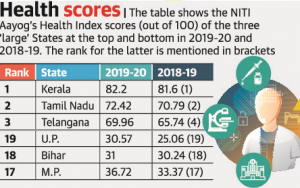
- Health Index is a weighted composite score incorporating 24 indicators covering key aspects of health performance. Health Index comprises of select indicators in three domains:
- Health Outcomes.
- Governance and Information; and
- Key Inputs and Processes.
- Each domain has been assigned weights based on its importance with higher score for outcome indicators.
- To ensure comparison among similar entities, the ranking is categorized as ‘Larger States’, ‘Smaller States’ and ‘Union Territories’.
- Among the ‘Larger States’, in terms of annual incremental performance, Uttar Pradesh, Assam and Telangana are the top three ranking states.
The Findings:
Among large states, Kerala and Tamil Nadu topped the list, and Telangana emerged strong on the third position in health outcomes and incremental performance. The state saw an improvement from the 4th position the last time — indicating that it has made strides in improving its health infrastructure by ensuring universal immunisation of children, setting up fully functional First Referral Units (FRUs) and all Primary Health Centres (PHCs) among others.
Among the ‘Larger States’, in terms of annual incremental performance, Uttar Pradesh, Assam and Telangana are the top three ranking states.
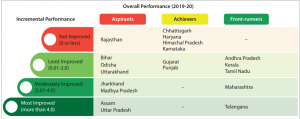
Among ‘Smaller States’, Mizoram and Meghalaya registered the maximum annual incremental progress.

Among UTs, Delhi, followed by Jammu and Kashmir, showed the best incremental performance.
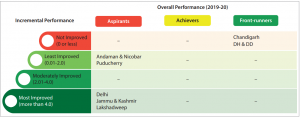
Key Points:
- For a vast majority of the states and UTs, there has been a shift in the Overall Performance ranking from Base Year (2018-19) to Reference Year (2019-20)
- The gap in the Overall Performance between the best and the worst performing Larger State and UTs narrowed in the current round of the Health Index, while it increased for the Smaller States.
- Nearly half the states and UTs did not reach the halfway mark in the Composite Overall Index Score, and despite good performance, even the top-ranking states and UTs could benefit from further improvements.
- The incremental changes in Health Index Scores from Base Year (2018-19) to Reference Year (2019-20) varied significantly across states and UTs, with a vast majority of Larger States registering at least some improvement.
The Conclusion:
- The Health Index is a useful tool to measure and compare the Overall Performance and Incremental Performance across states and UTs over time and nudging the states and UTs to shift the focus from inputs and outputs to outcomes.
- The Health Index has strengthened the culture of use of data at the state/UT level to monitor performance and is contributing to the agenda of improving availability, quality and timeliness of data.
2. RIGHT TO BE FORGOTTEN
THE CONTEXT: In December 2021, the Centre told the Delhi High Court that the “right to be forgotten” is part of the fundamental right to privacy, but added it has no significant role to play in the matter. Petitions across courts have been seeking enforcement of this “right” — a legal principle that is not yet backed by statute in India.
THE EXPLANATION:

What is the right to be forgotten?
- It allows a person to seek deletion of private information from the Internet. The concept has found recognition in some jurisdictions abroad, particularly the European Union. While the right is not recognised by law in India, courts in recent months have held it to be an intrinsic part of the right to privacy.
- At least eight petitions are pending before Delhi High Court seeking removal of private information from the Internet, court records of previous convictions and proceedings, and news reports of past events. Only a few have been able to get that relief from courts so far.
Which countries have such laws?
- The EU in 2018 adopted the General Data Protection Regulation (GDPR), Article 17 of which provides for the right to erasure of certain categories of personal data — that which is considered no longer necessary, that for which consent has been withdrawn or processing of which has been objected to, personal data unlawfully processed, and data where there is a legal obligation for erasure.
- However, the regulations limit the right to erasure in certain circumstances, including for reasons of public interest in the area of public health, for archiving purposes “in the public interest, scientific or historical research purposes or statistical purposes in accordance” and for “establishment, exercise or defence of legal claims.”
What is the position in India?
In a brief reply in one of the petitions earlier this week, the Centre told the Delhi High Court that the right to privacy has been recognised as a fundamental right in the K S Puttaswamy judgment (2017) and that the ‘right to be forgotten’ is evolving in India. The government said the Personal Data Protection Bill (a Joint Parliamentary Committee’s report on which was tabled on December 2021), contains provisions to the doctrine of the ‘right to be forgotten’.
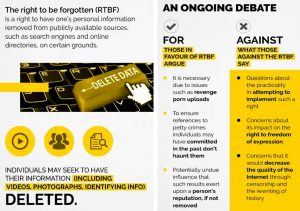
When can the right be exercised?
In the right to privacy judgment, the Supreme Court had clarified that the recognition of this right “does not mean that all aspects of earlier existence are to be obliterated, as some may have a social ramification”.
The SC explained: “If we were to recognise a similar right, it would only mean that an individual who is no longer desirous of his personal data to be processed or stored, should be able to remove it from the system where the personal data/information is no longer necessary, relevant, or is incorrect and serves no legitimate interest.”
The apex court asserted that this right cannot be exercised where the information or data is necessary for:
- exercising the right of freedom of expression and information.
- compliance with legal obligations.
- the performance of a task carried out in public interest, or public health.
- archiving purposes in the. public interest.
- scientific or historical research purposes or statistical purposes; or
- the establishment, exercise, or defence of legal claims.
CONCLUSION: Although the RTBF is a facet of the right to privacy, it has become very important in the digital age. The times when information is available at a click, the need to protect personal data becomes all the more important. Personal data such as related to matrimonial suits are of no relevance to the public. However, due to lack of proper legislation recognising this right people are subjected to harassment and loss of reputation. Therefore, legislation protecting this right is the need of the hour. Until then, the task is left to the judiciary which has to carefully tread its path between two fundamental rights- RTBF and freedom of expression.
THE INDIAN ECONOMY
3. TUSSLE OVER FCRA AND MISSIONARIES OF CHARITY (MoC)
THE CONTEXT: According to Union Home Ministry (MHA), the FCRA (Foreign Contribution Regulation Act) licence of Missionaries of Charity founded by Mother Teresa wasn’t renewed as some adverse inputs were received against it.
THE EXPLANATION:
- According to the 2020-21 annual financial returns filed by the MoC on December 13, 2021 it had received over ₹75 crore donation from 347 foreign individuals and 59 institutional donors. It had a balance of ₹27.3 crore in its FCRA account carried forward from the previous year and the total balance stood at ₹103.76 crore.
- The NGO registered in Kolkata has more than 250 bank accounts across the country to utilise the foreign funds. Some of the biggest donors are Missionaries of Charity in the U.S. and United Kingdom that contributed over ₹15 crore to MoC, India, for “primary health care, education assistance, treatment of leprosy patients” among others.
- The MoC in its statement clarified that “FCRA registration of Missionaries of Charity has neither been suspended nor cancelled. Further there is no freeze ordered by the Ministry of Home Affairs on any of our bank accounts”.
- The Foreign Contribution Regulation Act (FCRA) registration is mandatory for any NGO or association to receive foreign funds or donations.
- Mother Teresa had set up Missionaries of Charity, a Catholic religious congregation in 1950. She was awarded the Nobel Prize for Peace in 1979. She died on September 5, 1997, and was declared a saint by Pope Francis in September 2016.
- Registered associations can receive foreign contribution for social, educational, religious, economic and cultural purposes. Filing of annual returns, on the lines of Income Tax, is compulsory.
Value Addition:
Foreign Contribution (Regulation) Act:
- It is an act of Parliament enacted in 1976 and amended in 2010. It was to regulate foreign donations and to ensure that such contributions do not adversely affect internal security.
- Coverage: It is applicable to all associations, groups, and NGOs which intend to receive foreign donations.
- Registration: It is mandatory for all such NGOs to register themselves under the FCRA. The registration is initially valid for five years. Further, it can be renewed subsequently if they comply with all norms.
- Registered NGOs can receive foreign contributions for five purposes — social, educational, religious, economic, and cultural. There are 22,591 FCRA registered NGOs.
Foreign Contribution Regulation (Amendment) Rules 2020:
- New rules require any organization that wants to register itself under the FCRA to have existed for at least three years. Further, it should have spent a minimum of Rs. 15 lakh on its core activities during the last three financial years for the benefit of society.
- Office bearers of the NGOs seeking registration under the Foreign Contribution (Regulation) Act must submit a specific commitment letter from the donor. It should indicate the amount of foreign contribution and the purpose for which it is proposed to be given.
- Any NGO or person making an application for obtaining prior permission to receive foreign funds shall have an FCRA Account.
THE ENVIRONMENT AND ECOLOGY
4. AIR POLLUTION IN CENTRAL-WESTERN INDIA AND NORTH INDIA IN CONTRAST TO THE GENERAL TREND
THE CONTEXT: According to the study published in ‘Environmental Science and Pollution Research, by the Aryabhatta Research Institute of Observational Sciences (ARIES) showed that reduction of economic activities during the pandemic-related lockdown had resulted in decrease of air pollution in most parts of India, but satellite observations show that parts of central-western India and north India showed an increase in pollution in contrast to the general trend.
THE EXPLANATION:
- The satellite-based observation of toxic trace gases, — ozone, NO2, and carbon monoxide near the surface and in the free troposphere mostly showed reduction of the pollutants over India. However, over some regions like western – central India, some parts of Northern India, and Remote Himalaya, an increase of ozone and other toxic gases was observed. This could have aggravated respiratory health risks around those regions during the pandemic.
- Scientists have identified that regions in the central-western part of India and north India are prone to higher air pollution exposure based on state-of-the-art satellite observations and hence are exposed to greater risk of respiratory problems.
- Multi-satellite remote sensing of air pollutants has evolved dramatically over the last decade. Synergic measurements of satellite and in-situ observation provide a more comprehensive understanding of air pollution episodes. In 2020, a complete nationwide lockdown was imposed over India to impede the spread of coronavirus disease. This enormously disrupted the economy with a single positive side effect, a short-term improvement in the air quality near the surface.

- According to the results, carbon monoxide showed a consistent increase (as high as 31%) of concentration at higher heights during the lockdown. The long-range transport and downward transport from the stratosphere significantly increased ozone concentrations over north India during the lockdown, and remote regions like the Himalayas and coastal cities showed the bare minimum influence of lockdown in air quality, with a tendency to increase in criteria air pollutants.
- The ARIES team explains ozone production and loss are constrained through the complex photochemistry involving its precursor gases like nitrogen oxides (NOx) and volatile organic compounds (VOCs). A decrease in its precursor gases could also lead to enhancement of ozone, depending upon the chemical environment. Moreover, ozone concentrations are also altered via ambient meteorology and dynamics, including the downward transport of ozone-rich air from the stratosphere to the troposphere.
- According to the ARIES team, this study helped to identify the regions prone to higher air pollution exposure hence can identify areas at a greater health risk. The team previously, with scientists from the ISRO, showed INSAT-3D as a valuable Indian geostationary satellite to study ozone pollutions over India; however, for other criteria air pollutants (i.e., NO2, SO2, CO, VOCs, etc.), India is lacking in space-based observations and need air quality monitoring indigenous satellite in orbit.
Value Addition:
The six common air pollutants are:
- Particulate matter
- Ground-level ozone (Ground-level ozone is formed when volatile organic compounds (VOCs), also known as hydrocarbons, and nitrogen oxides (NOx) interact in the presence of sunlight.)
- Carbon monoxide
- Sulphur oxides
- Nitrogen oxides
5. IRANIAN KIWIS THREATEN KASHMIRI APPLES
THE CONTEXT: In early December 2021, the import of Iranian kiwis from Afghanistan to India has posed a major concern for apple dealers in Kashmir following a contagious quarantine pest threat found.
THE EXPLANATION:
- Since October 2021, India has intercepted quarantine pest ‘Aspidiotus netil’ in 22 consignments and ‘Pseudococcu Calceolariae’ pest in two Kiwi fruit consignments.
- According to the Union Ministry of Agriculture, India has suspended the import of fresh Kiwi fruits from Iran due to the rise in pest infested consignments from the middle eastern nation despite repeated warnings.

- The Import of Iran’s fresh Kiwi fruits has been banned with effect from December 2021 by the nodal body National Plant Protection Organization (NPPO) under the Agriculture Ministry.
- Earlier in 2019 too, India had intercepted a quarantine pest called ‘Aspidiotus netil’ from 13 consignments and a non-quarantine pest ‘Aonidiella aurantii’ from two consignments of Kiwi fruits from Iran. The non-compliance report has been sent on a regular basis to Iran for these consignments but so far no action has been taken nor the interception has decreased.”
- Also, the Ministry said the introduction of any quarantine pests through infested import consignments is a threat to Indian biosecurity and is dealt with under the provisions of Indian regulation.
- The Indian government has suspended the import of fresh kiwi fruits from India as each country has sovereignty and authority to protect itself. Iran government has also been requested to investigate the cases of non-compliance and submit an action taken report at the earliest with respect to remedial measures taken to avoid future interceptions.
- “Pests entering in the territory of any apple producing State shall be a catastrophe for local farmers”. Farmers have demanded a complete ban on import of apples from Iran “till the quarantine pest issue is resolved”.
- Currently, India imports 4,000 tonnes of Kiwis from various countries, while the domestic production is about 13,000 tonnes, as per the government data.
About Kashmir Apples:
- According to government figures, Kashmir exports around 20 lakh metric tons of apple every year, and the horticulture industry is pegged to be worth around 8000 to 9000 crores including the employment it generates. Kashmir produces 75% of the total apple production in the country.
National Plant Protection Organization (NPPO)
- The establishment or update of a National Plant Protection Organization (NPPO) by each contracting party is a major step towards international cooperation to prevent the introduction and spread of plant pests. This IPPC guide aims to support the establishment of a functional NPPO as the competent and legally responsible body for regulatory plant protection functions, as outlined in the IPPC.
THE SCIENCE AND TECHNOLOGY
6. 5G TECHNOLOGY
THE CONTEXT: According to the Department of Telecommunications (DoT) Delhi, Gurgaon, Mumbai, Bengaluru, Kolkata, Ahmedabad, Hyderabad, and Pune will be the first places to get 5G services next year i.e 2022.
THE EXPLANATION:
What is 5G technology and how is it different?
- 5G or fifth generation is the latest upgrade in the long-term evolution (LTE) mobile broadband networks. 5G mainly works in 3 bands, namely low, mid and high frequency spectrum — all of which have their own uses as well as limitations.
- While the low band spectrum has shown great promise in terms of coverage and speed of Internet and data exchange, the maximum speed is limited to 100 Mbps (Megabits per second).
- This means that while telcos can use and install it for commercial cell phone users who may not have specific demands for very high speed Internet, the low band spectrum may not be optimal for specialised needs of the industry.
- The mid-band spectrum, on the other hand, offers higher speeds compared to the low band, but has limitations in terms of coverage area and penetration of signals.
- The high-band spectrum offers the highest speed of all the three bands but has extremely limited coverage and signal penetration strength. Internet speeds in the high-band spectrum of 5G has been tested to be as high as 20 Gbps (giga bits per second), while, in most cases, the maximum internet data speed in 4G has been recorded at 1 Gbps.
Where does India stand in the 5G technology race?
- Like other global players, India had, in 2018, planned to start 5G services as soon as possible, with an aim to capitalise on the better network speeds and strength that the technology promised.
- All the three private telecom players, Reliance Jio Infocomm, Bharti Airtel and Vi, have been urging the DoT to lay out a clear road map of spectrum allocation and 5G frequency bands, so that they are able to plan the rollout of their services accordingly. One big hurdle, however, is the lack of flow of cash and adequate capital with at least two of the three players, namely Bharti Airtel and Vodafone Idea.
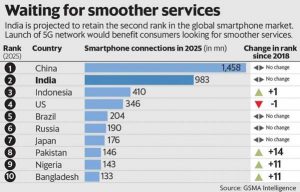
What is the global progress on 5G?
- More than governments, global telecom companies have started building 5G networks and rolling it out to their customers on a trial basis. In countries like the US, companies such as AT&T, T-mobile, and Verizon have taken the lead when it comes to rolling out commercial 5G for their users.
- In other countries such as China, some of the telcos such as China Unicom had started 5G trials as early as 2018, and have since rolled out the commercial services for users.

THE PRELIMS PRACTICE QUESTION
Q1. In the context of Colonial India, Shah Nawaz Khan, Prem Kumar Sehgal and Gurbaksh Singh Dhillon are remembered as:
a) leaders of Swadeshi and Boycott Movement
b) members of the Interim Government in 1946
c) members of the Drafting Committee in the Constituent Assembly
d) officers of the Indian National Army
ANSWER FOR 27TH DECEMBER 2021
ANSWER: D
EXPLANATION:
- Triclosan is a chemical with antibacterial properties. Generally, it is used in Toiletries. For decades, triclosan has been added to personal care products, such as hand soaps and cosmetics, and materials ranging from athletic clothing to food packaging. When you use a product containing triclosan, you can absorb a small amount through your skin or mouth.
Ethics Through Current Developments (28-12-2021)
Today’s Important Articles for Geography (28-12-2021)
Today’s Important Articles for Sociology (28-12-2021)
Today’s Important Articles for Pub Ad (28-12-2021)
WSDP Bulletin (28-12-2021)
(Newspapers, PIB and other important sources)
Prelim and Main
- Air pollution in parts of central-western India and north India increased during the pandemic in contrast to the general trend READ MORE
- NITI Aayog Releases Fourth Edition of State Health Index READ MORE
- Missionaries of Charity denied FCRA nod READ MORE
- Explained: What is 5G in telecom, and how will this tech work in India? READ MORE
- Right to be forgotten: govt position, court rulings, and laws elsewhere READ MORE
- PM Modi to lay foundation stone of 4 hydro power projects in Himachal Pradesh today. 7 points READ MORE
Main Exam
GS Paper- 1
- Why Centre wants to raise marriage age of women READ MORE
- What NFHS-5 data reveals about gender in India READ MORE
GS Paper- 2
POLITY AND GOVERNANCE
- Decoding the draft data protection law READ MORE
- Sacrilege: The law must prevail READ MORE
- Democracy in peril: Its spirit can’t be renewed without the power of emancipatory education READ MORE
- Protection from Data Protection Authority READ MORE
- Is the freedom of speech absolute? READ MORE
INTERNATIONAL ISSUES
- The prospects for Indo-Pak relations in 2022 READ MORE
- Central Asia of strategic import for India READ MORE
GS Paper- 3
ECONOMIC DEVELOPMENT
- The cold truth about India’s income inequality READ MORE
- Growing divergence in central and state-level fiscal trends READ MORE
- How to get the economy on the fast track READ MORE
- How India is wasting its potential demographic dividend READ MORE
ENVIRONMENT AND ECOLOGY
- The gaps in the plan to tackle plastic waste READ MORE
- Can India Use MNREGA Work To Make Itself More Climate-Resilient? READ MORE
- Tweaks in green laws may dilute safeguards, warn experts READ MORE
SECURITY
- A progressive step: Formation of a panel to look into withdrawal of AFSPA from Nagaland is a welcome move READ MORE
GS Paper- 4
ETHICS EXAMPLES AND CASE STUDY
- Desmond Tutu provided a model for constructive use of religious idioms in politics. In polarised times, he will be missed READ MORE
- We are not at peace with nature READ MORE
Questions for the MAIN exam
- ‘The spirit of democracy cannot be renewed without the enchanting power of emancipatory education or critical pedagogy’. Comment.
- ‘India’s relations with Central Asian countries have acquired a strategic dimension. It will be in India’s interest to augment its linkages with these countries to reduce their dependence on China’. Analyse.
QUOTATIONS AND CAPTIONS
- Democracy is the art and science of running the circus from the monkey cage.
- The linking of Aadhaar with voter ID will create complexities in the voter databases that will be hard to fix.
- An Aadhaar-voter ID linkage will also help political parties create voter profiles and influence the voting process.
- Criminalising the freedom of religion and choices, which is what the Indian compact is based on, by hunting out the diverse, mixed, or cosmopolitan as inauthentic has consequences, both social and economic.
- India’s political stability is not in question during the coming year, but there is intense hostility to any conversation with Pakistan among the government’s ideological base.
- For India to capture global markets, it must focus on boosting technology and digitalisation, strengthening environmental laws, and undertaking tax and business reforms.
- It undermines privacy; places unchecked powers in the hands of the State; holds the government to a much lower standard of accountability; makes unwarranted advances into areas beyond its mandate.
- A constitutional democracy cannot afford to normalise mob violence, and any constriction of due process and fair trial must be contested. Act against desecration but don’t allow people to take the law into their own hands.
- Democracy cannot be saved merely through the ritualisation of periodic elections; nor can it be saved through the occasional delivery of ‘relief packages’ to the poor. Democracy needs our alertness and courage — and this requires the light of critical pedagogy.
50-WORD TALK
- India’s relations with Central Asian countries have acquired a strategic dimension. Kazakhstan and Uzbekistan have emerged as important suppliers of uranium to fuel India’s nuclear power plants. Tajikistan provided critical help in the evacuation of Indians from Afghanistan. It will be in India’s interest to augment its linkages with these countries to reduce their dependence on China.
- Call it a ‘precaution dose’ or a booster shot, what matters is the Modi government has finally come around and agreed to administer these. But why wait until 3 Jan or 10 Jan for the different categories when Omicron is so much more transmissible? Only India’s health bureaucrats would know.
Things to Remember:
- For prelims-related news try to understand the context of the news and relate with its concepts so that it will be easier for you to answer (or eliminate) from given options.
- Whenever any international place will be in news, you should do map work (marking those areas in maps and also exploring other geographical locations nearby including mountains, rivers, etc. same applies to the national places.)
- For economy-related news (banking, agriculture, etc.) you should focus on terms and how these are related to various economic aspects, for example, if inflation has been mentioned, try to relate with prevailing price rises, shortage of essential supplies, banking rates, etc.
- For main exam-related topics, you should focus on the various dimensions of the given topic, the most important topics which occur frequently and are important from the mains point of view will be covered in ED.
- Try to use the given content in your answer. Regular use of this content will bring more enrichment to your writing.
DAILY CURRENT AFFAIRS (DECEMBER 26 & 27, 2021)
THE INDIAN POLITY AND GOVERNANCE
1. GOOD GOVERNANCE INDEX 2021
THE CONTEXT: Union Minister of Home Affairs released the Good Governance Index 2021 prepared by the Department of Administrative Reforms and Public Grievances (DARPG) on 25 December 2021 which is celebrated as Good Governance Day.
THE EXPLANATION:
Why December 25?
- 25th December is celebrated as Good Governance Day marking the auspicious occasion of late former Prime Minister, Atal Bihari Vajpayee’s birth anniversary. Good Governance is the key component of the economic transformation and with the present government’s focus on ‘minimum government and maximum governance,’ the Index assumes more significance.
What is the Good Governance Index (GGI)?
- GGI is a comprehensive and implementable framework to assess the State of Governance across the States and UTs which enables ranking of States/Districts. The objective of GGI is to create a tool that can be used uniformly across the States to assess the impact of various interventions taken up by the Central and State Governments including UTs.
- Based on the GGI Framework, the Index provides a comparative picture among the States while developing a competitive spirit for improvement. The GGI 2019 encompassed 10 Governance Sectors and 50 Governance Indicators.
- For GGI 2020-21, the same 10 Governance Sectors are retained while indicators have been revised to 58, namely,
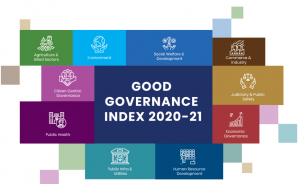
Further, the GGI 2020-21 categorizes States and UTs into four categories, i.e.,
- Other States – Group A;
- Other States – Group B;
- North-East and Hill States; and
- Union Territories.
With a “Citizen-Centric Administration” approach at the heart of the government’s Governance Model – this year, 20 States have improved their composite GGI scores over the GGI 2019 index scores.
Data Source:
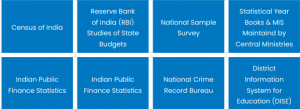
Top ranking States and UT’s
Analysis of the Index:
- As per the GGI 2021 rankings, Uttar Pradesh has shown an incremental growth of 8.9% over GGI 2019 performance. Among the sectors, it has secured top position in Commerce & Industry sector including an increase in Social Welfare & Development and Judiciary & Public Safety. The state has also performed well in citizen-centric governance including public grievance redressal.
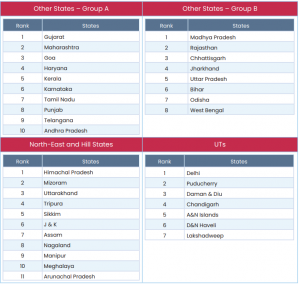
- Jharkhand witnessed a growth of 12.6 per cent over GGI 2019 performance in 7 of the 10 sectors. Rajasthan has shown an incremental growth of 1.7 per cent over the past year’s index and topped the Other States (Group B) category in Judiciary and Public Safety, Environment & Citizen Centric Governance.
- In the North-East and Hill States category, Mizoram and Jammu and Kashmir registered an overall increase of 10.4% and 3.7% respectively over GGI 2019. The latter has performed strongly in Commerce & Industry sector and has improved its scores in Agriculture & Allied Sector, Public Infrastructure and Utilities and Judiciary and Public Safety sectors. Mizoram too has performed strongly in commerce and industry, human resource development, public health and economic governance.
This GGI 2021 indicates that overall governance in the States of India is moving in a positive direction. The end results of these rankings are to improve citizen services and make the government inclusive and accountable.
INDIAN ECONOMY
2. INDIA IMPOSES ANTI-DUMPING DUTY ON CHINESE GOODS
THE CONTEXT: India has imposed anti-dumping duty on five Chinese products, including certain aluminium goods and some chemicals, for five years to guard local manufacturers from cheap imports from the neighbouring country.
THE EXPLANATION:
- According to notifications of the Central Board of Indirect Taxes and Customs (CBIC), the duties have been imposed on certain flat rolled products of aluminium; sodium hydrosulphite (used in dye industry); silicone sealant (used in manufacturing of solar photovoltaic modules, and thermal power applications); hydrofluorocarbon (HFC) component R-32; and hydrofluorocarbon blends (both have uses in refrigeration industry).
- These duties were imposed following recommendations of the Commerce Ministry’s investigation arm, the Directorate General of Trade Remedies (DGTR).
- The CBIC has also imposed the duty on a vehicle component — Axle for Trailers in CKD/SKD (complete and semi knocked down) to protect domestic makers from cheap Chinese imports.
- Similarly it has also slapped the duty on imports of calcined gypsum powder from Iran, Oman, Saudi Arabia and the United Arab Emirates for five years.
What is anti-dumping duty?
- Anti-dumping duty is imposed to rectify the situation arising out of the dumping of goods and its trade distortive effect.
- According to global trade norms, including the World Trade Organization (WTO) regime, a country is allowed to impose tariffs on such dumped products to provide a level-playing field to domestic manufacturers.
How is it different from Counter Vailing Duty?
- Anti-dumping duty is different from countervailing duty. The latter is imposed in order to counter the negative impact of import subsidies to protect domestic producers.
- Countervailing Duties (CVDs) are tariffs levied on imported goods to offset subsidies made to producers of these goods in the exporting country.
- CVDs are meant to level the playing field between domestic producers of a product and foreign producers of the same product who can afford to sell it at a lower price because of the subsidy they receive from their government.
3. WORLD ECONOMY TO TOP $100 TRILLION IN 2022
THE CONTEXT: According to World Economic League Table report released by british consultancy CEBR predicted that China will become the world’s top economy in dollar terms in 2030, two years later than forecast in 2020.
THE EXPLANATION:
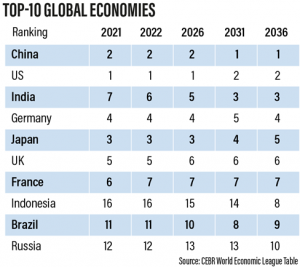
- The world’s economic output will exceed $100 trillion for the first-time next year, and it will take China a little longer than previously thought to overtake the United States as the No.1 economy.
- India looks set to overtake France next year and then Britain in 2023 to regain its place as the world’s sixth biggest economy.
- Also they stated, the important issue for the 2020s is how the world economies cope with inflation, which has now reached 6.8% in the U.S.
- The report showed Germany was on track to overtake Japan in terms of economic output in 2033. Russia could become a Top 10 economy by 2036 and Indonesia looks on track for ninth place in 2034.
What is the current state of Indian economy?
India’s gross domestic product (GDP) at current prices stood at Rs. 51.23 lakh crore (US$ 694.93 billion) in the first quarter of FY22, as per the provisional estimates of gross domestic product for the first quarter of 2021-22.

THE SCIENCE AND TECHNOLOGY
4. JAMES WEBB SPACE TELESCOPE MISSION
THE CONTEXT: NASA’s James Webb Space Telescope (JWST) was launched successfully from the European Space Agency’s (ESA) launch base in French Guiana.
THE EXPLANATION:
- NASA’s largest space science telescope ever constructed, will be the successor of the Hubble Space Telescope, that has been in service for more than three decades now.
- The powerful $9 billion infrared telescope, hailed by NASA as the premiere space-science observatory of the next decade, was carried aloft inside the cargo bay of an Ariane 5 rocket.
- According to NASA, the Carrying four main scientific instruments, Near-Infrared Camera, Near-Infrared Spectrograph, Mid-Infrared Instrument, and Near-Infrared Imager and Slitless Spectrograph, Webb will “hunt for the unobserved formation of the first galaxies, as well as to look inside dust clouds where stars and planetary systems are forming today”.
- JWST has the ability to look in the infrared spectrum, which will allow it to peer through much deeper into the universe and see-through obstructions such as gas clouds.
About James Webb Space Telescope (JWST or Webb)
JWST is an engineering marvel comparable to the earth-based Event Horizon Telescope that produced the photograph of the black hole, or the LIGO that detected the gravitational waves. It is widely expected to unveil many secrets of the universe, particularly those related to the formation of stars and galaxies in the early period — the first few hundred million years — after the Big Bang.
- It has been jointly developed by NASA, Canadian Space Agency (CSA) and the European Space Agency (ESA). As NASA’s flagship astrophysics mission, it is planned to succeed the Hubble Space Telescope.
- The primary mirror of JWST that is, Optical Telescope Element, comprises of 18 hexagonal mirror segments. These segments are made up of gold-plated beryllium.
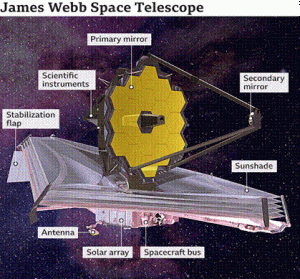
Objectives and functions of the telescope:
- It will look deeper into the cosmos – and thus further back in time – than is possible with Hubble.
- It will do this with a much bigger mirror (6.5m in diameter versus 2.4m) and instruments that are tuned to the infrared.
- Scientists hope this set-up can detect the light from the very first population of stars in the Universe to switch on more than 13.5 billion years ago.
Where it is placed?
The James Webb Space Telescope will not be in orbit around the Earth, like the Hubble Space Telescope is – it will actually orbit the Sun, 1.5 million kilometres (1 million miles) away from the Earth at what is called the second Lagrange point or L2.
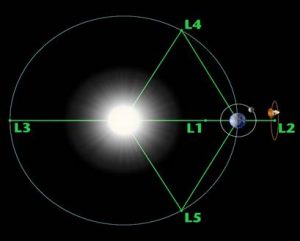
5. THE SMELL FACTOR
THE CONTEXT: Researchers at Karolinska Institute in Sweden have found that negative smells associated with unpleasantness or unease are processed earlier than positive smells and trigger a physical avoidance response.
THE EXPLANATION:
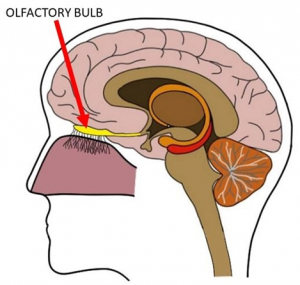
The cognitive process is not only unconscious but is also extremely rapid, this goes against the conventional wisdom that unpleasant smells associated with danger is a conscious cognitive process.
- The olfactory organ takes up about 5% of the human brain and enables us to distinguish between many million different smells. A large proportion of these smells are associated with a threat to our health and survival, such as that of chemicals and rotten food. In humans, the olfactory sense seems particularly important for detecting and reacting to potentially harmful stimuli. Until recently, it was not known which neural mechanisms are involved in the conversion of an unpleasant smell into avoidance behaviour in humans.
- The reason: lack of non-invasive methods of measuring signals from the olfactory bulb, the first part of the rhinencephalon with direct connections to the important central parts of the nervous system that helps us detect and remember threatening and dangerous situations and substances
- According to the National Academy of Sciences release, the three experiments were carried out in which participants were asked to rate their experience of six different smells, some positive, some negative, while the electrophysiological activity of the olfactory bulb when responding to each of the smells was measured. And they found that the bulb reacts specifically and rapidly to negative smells and sends a direct signal to the motor cortex within about 300 milliseconds.
- The researchers have for the first time made it possible to measure signals from the human olfactory bulb, which processes smells and in turn can transmits signals to parts of the brain that control movement and avoidance behaviour.
What are Olfactory Bulbs?
A rounded mass of tissue that contains several types of nerve cells that are involved in the sense of smell. The olfactory bulbs receive information about smells from the nose and send it to the brain by way of the olfactory tracts.
THE GOVERNMENT SCHEMES/ INITIATIVES IN NEWS
6. TELANGANA TOPS IN IMPLEMENTATION OF RURBAN MISSION
THE CONTEXT: Telangana stood first in the implementation of the Shyama Prasad Mukherji Rurban Mission (SPMRM) that was launched in 2016, to stimulate local economic development, enhance basic services and create well planned clusters.
THE EXPLANATION:
- Sangareddy and Kamareddy districts stood in the first two positions among the 300 clusters across the country where the programme was being implemented.
- Tamil Nadu and Gujarat took the second and third positions respectively.
- In Telangana, in as many as 17 clusters (12 non-tribal and five tribal), the programme was being implemented at an estimated cost of ₹1,885.12 crore.
“The establishment of a bulk milk chilling unit at Narayanakhed had benefited about 3,500 farmers, income ranging between ₹50,000 and ₹2.5 lakh per annum, depending on the number of milch animals. A plastic waste treatment unit and millet processing unit are also coming up at Ryakal cluster,”
Value Addition:
SHYAMA PRASAD MUKHERJI RURBAN MISSION (SPMRM)- NATIONAL RURBAN MISSION (NRUM)
Objective
The objective of the National Rurban Mission (NRuM) is to stimulate local economic development, enhance basic services, and create well planned Rurban clusters. It is established in 2016 as a centrally sponsored scheme, and it comes under the Ministry of Rural Development.
Outcomes
- The larger outcomes envisaged under this Mission are:
- Bridging the rural-urban divide-viz: economic, technological and those related to facilities and services.
- Stimulating local economic development with emphasis on reduction of poverty and unemployment in rural areas.
- Spreading development in the region.
- Attracting investment in rural areas.
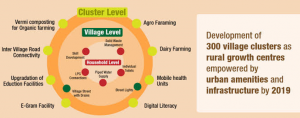
Rurban Cluster
A ‘Rurban cluster’, would be a cluster of geographically contiguous villages with a population of about 25000 to 50000 in plain and coastal areas and with a population of 5000 to 15000 in desert, hilly or tribal areas. As far as practicable, clusters of villages would follow administrative convergence units of Gram Panchayats and shall be within a single block/tehsil for administrative convenience.
THE PRELIMS PRACTICE QUESTION
Q1. ‘Triclosan’, considered harmful when exposed to high levels for a long time, is most likely present in which of the following?
a) Food preservatives b) Fruit-ripening substances
c) Reused plastic containers d) Toiletries
ANSWER FOR 25TH DECEMBER 2021
Answer: d)
Explanation:
- Statement 1 is incorrect: Indian Constitution provides for the establishment of the Election Commission with the composition of the Chief Election Commissioner and as many Election Commissioners as President may fix from time to time. It is not necessarily a multi-member body.
- Statement 2 is incorrect: CEC and ECs have equal powers and equal salary, allowances which are similar to a judge of a Supreme Court.
- Statement 3 is incorrect: Constitution has not debarred CEC and ECs from any further appointment by the government after their retirement
Today’s Important Articles for Pub Ad (27-12-2021)
Today’s Important Articles for Sociology (27-12-2021)
Today’s Important Articles for Geography (27-12-2021)
Ethics Through Current Developments (27-12-2021)
WSDP Bulletin (27-12-2021)
(Newspapers, PIB and other important sources)
Prelim and Main
- NITI Aayog to release the fourth edition of “The Healthy States, Progressive India” ranking States performance on 27th of December 2021 READ MORE
- MISSION SAGAR READ MORE
- Deendayal Antyodaya Yojana-National Rural Livelihoods Mission Overdraft facility for women SHG members launched READ MORE
- Explained | What are the head and tailwinds in the economy? READ MORE
- Telangana tops in implementation of Rurban Mission READ MORE
- India imposes anti-dumping duty on 5 Chinese goods for 5 years READ MORE
- NSE launches ‘Prime’ for companies willing to raise governance bar READ MORE
Main Exam
GS Paper- 1
- Growth estimates and social tensions READ MORE
GS Paper- 2
POLITY AND GOVERNANCE
- Right to be forgotten: govt position, court rulings, and laws elsewhere READ MORE
- How PMO letter to EC challenged institutional balance READ MORE
- Democracy and the US-India relationship READ MORE
- Another migration Bill in the making READ MORE
SOCIAL ISSUES AND SOCIAL JUSTICE
- Prevention is better than cure: There are several compelling reasons for extending outpatient health care coverage READ MORE
INTERNATIONAL ISSUES
- A chance to tap India’s high equity in Myanmar: Though there are challenges, the momentum gained from the Indian Foreign Secretary’s recent visit must not be lost READ MORE
GS Paper- 3
ECONOMIC DEVELOPMENT
- India needs a realistic model of education to raise employment READ MORE
- Macro-economics of a circular economy through aluminium READ MORE
- Agriculture needs a booster dose READ MORE
ENVIRONMENT AND ECOLOGY
- Receding glaciers: Risk from climate change has to be minimised READ MORE
- Changes in biodiversity law may weaken regulation READ MORE
- River Linking is a Prestige Project, will not Solve Water Crisis READ MORE
DISASTER MANAGEMENT
- Disaster management: How India is improving its existing capabilities READ MORE
SECURITY
- Security Jeopardised? READ MORE
GS Paper- 4
ETHICS EXAMPLES AND CASE STUDY
Questions for the MAIN exam
- ‘The national good requires that the three organs of the state and independent constitutional bodies function harmoniously in accordance with their constitutional and legal mandates’. Comment.
- ‘India’s geo-climatic conditions make it one of the most disaster-prone countries in the world. International cooperation in disaster management is critical to India for the effective handling of disasters within its borders as well as the region’. Analyse.
- ‘Democracy is pointless without debate and discussion and a dysfunctional Parliament leads to dysfunctional democracy’. Comment.
QUOTATIONS AND CAPTIONS
- If we don’t end war, war will end us.
- To deter supply-side malpractices, low-powered modes of provider payment, such as capitation, may be considered for private providers wherever possible.
- The national good requires that the three organs of the state and independent constitutional bodies function harmoniously in accordance with their constitutional and legal mandates.
- The historical experience of the ages shows that all political power is inherently expansive.
- Consultations between independent institutions and the executive should occur, but it would be appropriate and graceful for the political and bureaucratic executive to show respect for independent institutions.
- Skills are indispensable in the changing scenario of the 21st century. Communication is a game-changer and social order to meet the growing demands of the workforce.
- Freedom is the basic fundamental value of human soul freedom is what gives meaning to human life.
- Modern values and traditional social ethical values must promote and enhance human dignity and promote inclusive and equitable development along with social justice.
- Dignity of labour needs advocacy to help our youth bridge gaps between aspirations and abilities.
- India’s geo-climatic conditions make it one of the most disaster-prone countries in the world. International cooperation in disaster management is, therefore, critical to India for the effective handling of disasters within its borders as well as the region.
- Govt policies need to serve society at large with the aim of protecting biodiversity and associated traditional knowledge against commercial exploitation by a few private entities.
- Democracy is not just about an elected Parliament and periodic elections. Democracy is pointless without debate and discussion and a dysfunctional Parliament leads to dysfunctional democracy.
50-WORD TALK
- RBI move to postpone the tokenisation of credit/debit cards is a relief. RBI’s intentions to make online transactions more secure are commendable. But the central bank has been obstinate about it, ending up disrupting transactions and even hurting businesses. In the process, digitalisation has become a bit of a circus.
- Allahabad judge Shekhar Kumar Yadav’s cautionary note on Omicron urging PM Modi to take strong steps during election campaign cannot be lauded enough. Indians must be reminded about the West Bengal campaign that fueled the disastrous second wave. EC’s Covid norms aren’t heeded, so a judge had to step up.
Things to Remember:
- For prelims-related news try to understand the context of the news and relate with its concepts so that it will be easier for you to answer (or eliminate) from given options.
- Whenever any international place will be in news, you should do map work (marking those areas in maps and also exploring other geographical locations nearby including mountains, rivers, etc. same applies to the national places.)
- For economy-related news (banking, agriculture, etc.) you should focus on terms and how these are related to various economic aspects, for example, if inflation has been mentioned, try to relate with prevailing price rises, shortage of essential supplies, banking rates, etc.
- For main exam-related topics, you should focus on the various dimensions of the given topic, the most important topics which occur frequently and are important from the mains point of view will be covered in ED.
- Try to use the given content in your answer. Regular use of this content will bring more enrichment to your writing.
Day-112 | Daily MCQs | UPSC Prelims | GENERAL SCIENCE
| [WpProQuiz 122] |
DAILY CURRENT AFFAIRS (DECEMBER 25, 2021)
THE INDIAN POLITY AND GOVERNANCE
1. SOYA MEAL AS AN ESSENTIAL COMMODITY
THE CONTEXT: In a bid to cool down the domestic prices of Soya Meal, Government has notified an Order under the Essential Commodities Act to declare ‘Soya Meal’ as an Essential Commodities up to 30th June 2022 by amending the Schedule of the Essential Commodities Act, 1955.
THE EXPLANATION:
- The decision would empower the Union Government and all States/UTs to regulate production, distribution etc. of Soya Meal and to smoothen the sale and availability of this item in the market. It will stop unfair market practices and enhance the availability for consumers like Poultry farm and Cattle feed manufacturers.
According to the ministry, the following stock limits have been promulgated of all Soya meal for a period upto 30 June 2022 with following stock limits for all States and Union Territories:
- Plant/Miller/Processor: Maximum stock of 90 days production, as per daily input production capacity of Plant/Miller/Processor, defined in its IEM. The storage location should be declared.
- Trading company/Trader/Private Chaupals: Only Government registered enterprise, maximum stock of 160 MT with a defined and declared storage location.
- These measures are expected to stop any unfair practices (like hoarding, black marketing, etc.) in the market having the potential to hike the prices of Soya Meal. Consequently, the market price of Soyabean Oil will cool down.
What is meant by the Essential Commodity Act?
The Act gives powers to the central government to add or remove a commodity in the “Schedule.” The Centre, if it is satisfied that it is necessary to do so in public interest, can notify an item as essential, in consultation with state governments.
At present, the “Schedule” contains 9 commodities — drugs; fertilisers, whether inorganic, organic or mixed; foodstuffs, including edible oils; hank yarn made wholly from cotton; petroleum and petroleum products; raw jute and jute textiles; seeds of food-crops and seeds of fruits and vegetables, seeds of cattle fodder, jute seed, cotton seed; face masks; and hand sanitisers.
How and under what circumstances can the government impose stock limits?
- Under the amended EC Act, agri-food stuffs can only be regulated under extraordinary circumstances such as war, famine, extraordinary price rise, and natural calamity.
- However, any action on imposing stock limits will be based on the price trigger.
- Thus, in case of horticultural produce, a 100 per cent increase in the retail price of the commodity over the immediately preceding 12 months or the average retail price of the last five years, whichever is lower, will be the trigger for invoking the stock limit for such commodities.
- For non-perishable agricultural foodstuffs, the price trigger will be a 50 per cent increase in the retail price of the commodity over the immediately preceding 12 months or the average retail price of the last five years, whichever is lower.
THE SOCIAL ISSUES AND SOCIAL JUSTICE
2. LIFE EXPECTANCY REDUCED IN 2020
THE CONTEXT: According to the report published in the British Medical Journal November 2021 Observed that life expectancy in 2020 reduced in 29 of the 37 countries surveyed compared to the expected figures, decreased by 1.1-2.3 years for men and 1.1-2.1 years for women.
THE EXPLANATION:
- The reduction of life expectancy across the globe during the first year of the novel coronavirus disease (COVID-19) pandemic was alarming, reversing progress made in past years, “more than 28 million excess years of life were lost in 2020 in 31 countries, with a higher rate in men than women.
- Also, the study noted, the excess years of life lost associated with the COVID-19 pandemic in 2020 were more than five times higher than those associated with the seasonal influenza epidemic in 2015”.
- Russia recorded the largest drop in life expectancy — for men it fell by 2.33 years and for women by 2.14 years. This was followed by the United States, where the figure for men reduced by 2.27 years and by 1.61 for women.
- New Zealand, Taiwan and Norway recorded increases while the figures remained unchanged for Denmark, Iceland, and South Korea.
- Prior to the COVID-19 pandemic, all 37 countries recorded an increase in life expectancy between 2005 and 2019. Only in 2015 was there an anomaly, where life expectancy dropped during the influenza outbreak.
- According to the report “the overall, the excess years of life lost (YLL) in the 37 countries was 5 times higher during the COVID-19 pandemic in 2020 than the excess YLL associated with the seasonal influenza epidemic in 2015. The absolute difference was of 2,050 years of life lost per 100,000.
INDIAN ECONOMY
3. MONETARY POLICY IS FINANCIALLY INCLUSIVE’
THE CONTEXT: According to the RBI deputy Governor, India’s monetary policy is by design financially inclusive, the evidence of which is still coalescing, and increased inclusion will over time enhance policy effectiveness by fostering societal intolerance to inflation.
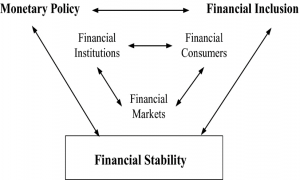
THE EXPLANATION:
- “Although it is empirically observed that there is a two-way relationship between monetary policy and financial inclusion, it is unambiguous that financial inclusion is able to dampen inflation and output volatility”.
- “This is achieved by smoothing consumption by enabling people to draw down financial savings in difficult times for everyday needs. In the process, it makes people interest sensitive. Moreover, inflation targeting monetary policy ensures that even those at the fringe of financial inclusion are secured from adverse income shocks that hit them when prices rise unconscionably”.
- Observing that financial inclusion appeared to have increased, with the level of the RBI’s financial inclusion index rising from 9 in March 2019, to 53.1 in March 2020, and further to 53.9 in March 2021: “The evidence is still forming and strong conclusions from its analysis may be premature, but India’s monetary policy is by design” inclusive.
- Financial inclusion appeared to be the lowest in rural, agriculture-dependent areas where food was the main source of income.
Price stability target
- In this kind of a situation, the efficacy of monetary policy in achieving its stabilisation objective increases by targeting a measure of prices that includes food prices rather than one that excludes them such as core inflation.
- In India, food accounts for 46% of the CPI, among the highest shares globally.
- “The lower the level of financial inclusion, therefore, the stronger is the case for price stability being defined in terms of headline inflation rather than any measure of core inflation that strips out food and fuel”.
How to measure Financial Inclusion?
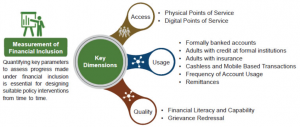
THE ENVIRONMENT AND ECOLOGY
4. RECORD DEMAND FOR COAL POWER IN 2021
THE CONTEXT: According to International Energy Agency (IEA), Carbon emissions from coal will be 3 gigatonnes higher in 2024 than required to achieve Net Zero emissions by 2050.
THE EXPLANATION:
- The Global demand for coal-fired electricity has grown 6 per cent in 2021 to 7,906 million tonnes (Mt) and generation 9 per cent to 10,350 terawatt-hours (TWh), according to a new report. Generation has increased 12 per cent in India and 9 per cent in China, a record for both.
- On the supply side, coal production did not keep pace with demand, Shortages occurred due to supply chain issues and adverse weather conditions leading to “power outages and idled factories.
- IEA projected, major coal producing countries such as China, India, Indonesia and Russia are expected to boost production. As a result, coal production will hit its highest level in 2022 and then plateau as demand flattens.
Coal was in focus at the 26th Conference of Parties (COP 26) to the United Nations Framework Convention on Climate Change in Glasgow November 2021. “Cash, coal, cars and trees” was the marketing term used by United Kingdom Prime Minister to capture the UK’s strategy at the summit.
Net Zero Commitment:
- Several countries made commitments to phase out coal power or stop financing coal abroad through announcements like the Global Coal to Clean Power Transition Statement and the Powering Past Coal Alliance. Despite this, the new IEA report finds that the 2021 rebound in coal consumption and future trends will result in three gigatons higher CO2 emissions from coal in 2024 than its Net Zero Emissions by 2050 Scenario (NZE). The NZE outlines a roadmap for the energy sector to achieve net-zero carbon emissions by 2050.
- China dominates coal use globally; “it is the largest consumer, producer and importer – has no parallel with any other country”, said IEA in the report. The country’s coal consumption is more than half of the global total, despite efforts to expand hydro, wind, solar and nuclear power.
India’s Picture:
- In India, coal comprised 74 per cent of the power mix in 2021, up from 72 per cent in 2020. As electricity access expands, coal demand is expected to increase by 3.9 per cent on average till 2024.EFENCE AND SECURITY
- The country plans to boost domestic coal production following the 2021 shortages, rising to an expected 955 Mt by 2024 from 793 Mt in 2021, according to IEA. This is a far cry from India’s support of a coal “phase-down” in the final text of the COP 26 pact – a thorny issue, that attracted a fair amount of backlash from Western media outlets, despite receiving support from countries like China and US.
- India’s ground reality is complex. Keeping its multiple developmental goals of energy access, livelihoods and poverty reduction in mind, the transition away from coal must be done with clear strategic intent and deliberate planning.
At the same time, the co-benefits of transitioning to a zero-carbon energy system as soon as possible are undeniable. And the Union government’s domestic efforts do not echo its global statements.
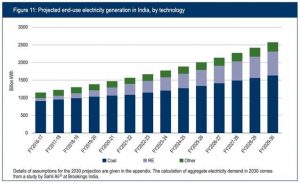
5. PRALAY QUASI-BALLISTIC MISSILE
THE CONTEXT: The Defense Research and Development Organization (DRDO) successfully carried out the maiden test of ‘Pralay’, a new surface-to-surface conventional quasi-ballistic missile, in a boost for India’s tactical battlefield strategy.
THE EXPLANATION:
- A quasi-ballistic missile has a low trajectory, and while it is largely ballistic, it can manoeuvre in flight. The missile has a range of 150-500 kilometers and has been developed according to specifications given by eventual user, the Army.
- According to the Defense Ministry, new missile reached the designated target with a high degree of accuracy, validating the control, guidance and mission algorithms.
Significance:
- The missile is powered with a solid propellant rocket motor and multiple new technologies. Sources in the defense establishment underlined that accuracy is a highlight of this missile.
- Capable of being launched from a mobile launcher, it has the latest navigation system and integrated avionics, and will be part of the Artillery Corps of the Army.
- Pralay will be the longest-range surface-to-surface missile in the inventory of the Army, which sources said will give a fillip to their operational plans.
- The Army also has the BrahMos supersonic cruise missile in its arsenal, with a stated range of 290-plus kilometers.
‘Change tactical battlefield dynamics’
- According to the Scientist, “It will completely change the tactical battlefield dynamics and India will have two conventional missiles with long range. The BrahMos will be a cruise option and this one will be the ballistic option. Cruise missiles and ballistic missiles have their own distinct advantages.
- While cruise missiles have high agility, stealth and even loitering capability, ballistic missiles have the advantage of speed and countering them is a very difficult task even for modern air defence systems.
6. INS SUDARSHINI DEPLOYMENT TO GULF COUNTRIES
THE CONTEXT: INS Sudarshini is presently on its culmination phase of deployment to Gulf region as part of Indian Navy’s efforts towards familiarising friendly foreign navies on various facets of operations and training on board sail training platforms and extending ‘Bridges of Friendship’.
THE EXPLANATION:

- IRI Navy Trainee officers (Sea Riders) designated to undergo sail training visited the ship for a familiarisation tour of the ship. Practical knowledge on subjects of seamanship, sail arrangement, rope work and the technicalities of sail training were shared. Hands-on practical knowledge and experience on sail rigging of both sides was also imparted during this visit.
- The ship would be staying at Bandar Abbas for three days which includes a visit to Naval Base (Bandar Abbas) and embarkation of Sea Riders from the IRI Navy to provide sail training experience over a day’s sortie.
PLACES IN NEWS:
IMPORTANCE OF BANDAR ABBAS
- The Port of Bandar Abbas is over 575 nautical miles (775 kilometers or 482 miles direct) southeast of Iran’s Imam Khomeini Port.
- The International North-South Transport Corridor (INSTC) is a 7,200-km-long network of moving freight by ships, railways, and roads. The corridor aims to connect India, Iran, Afghanistan, Azerbaijan, Russia, Central Asia and Europe via Bandar Abbas. The cities that would be interlinked by this corridor include Mumbai, Moscow, Tehran, Baku, Bandar Abbas, Astrakhan, and Bandar Anzali.
- This will also synchronize with the Ashgabat agreement, a Multimodal transport agreement signed by India, Oman, Iran, Turkmenistan, Uzbekistan and Kazakhstan, for creating an international transport and transit corridor facilitating transportation of goods between Central Asia and the Persian Gulf.
THE PRELIMS PRACTICE QUESTION
1. Consider the following statements about Election Commission:
- Indian Constitution provides for establishment of Election Commission as multi-member
- CEC and ECs have equal powers and equal salary, allowances which are similar to a judge of a High Court.
- Constitution has debarred CEC and ECs from any further appointment by government after their retirement.
Which of the statements given above is/are incorrect?
a) 1 only b) 1 and 2 only
c) 2 and 3 only d) All of them
ANSWER FOR 24TH DECEMBER 2021
Answer: a)
Explanation:
Eligibility criteria:
- Adult woman (attained 18 years of age) belonging to any of the following categories.
- SC Households
- ST Households
- Pradhan Mantri Awas Yojana (Gramin)
- Most Backward Classes
- Antyodaya Anna Yojana (AAY)
- Tea and Ex- Tea Garden tribes
- Forest Dwellers
- People residing in Islands and River Islands
- SECC Households (AHL TIN)
- Poor Household as per 14-point declaration
Ethics Through Current Developments (24-12-2021)
Today’s Important Articles for Geography (24-12-2021)
Today’s Important Articles for Sociology (24-12-2021)
Today’s Important Articles for Pub Ad (24-12-2021)
- Understanding the Election Laws (Amendment) Bill, 2021 READ MORE
- Another session of House discord: The government and Opposition must develop channels of communication to resolve extant issues READ MORE
- UAPA conviction rate: Need to curb misuse of anti-terror law READ MORE
- ED’s powers and functions call for scrutiny READ MORE
WSDP Bulletin (24-12-2021)
(Newspapers, PIB and other important sources)
Prelim and Main
- DRDO successfully conducts Flight-Test of Indigenous Aerial Target ‘Abhyas’ READ MORE
- Turtle trail to get a boost with mass tagging mission READ MORE
- RBI extends tokenisation deadline by 6 months READ MORE
- The world’s leggiest animal has been discovered in Australia READ MORE
- South Korea becomes 10th non-European country to join Europol READ MORE
- Maharashtra: Assembly passes Bill approving death penalty for rape READ MORE
Main Exam
GS Paper- 1
- Raising the marriage age is not the solution READ MORE
- Early Narasimha sculptures from Karnataka READ MORE
GS Paper- 2
POLITY AND GOVERNANCE
- Understanding the Election Laws (Amendment) Bill, 2021 READ MORE
- Another session of House discord: The government and Opposition must develop channels of communication to resolve extant issues READ MORE
- UAPA conviction rate: Need to curb misuse of anti-terror law READ MORE
- ED’s powers and functions call for scrutiny READ MORE
SOCIAL ISSUES AND SOCIAL JUSTICE
- This clean cooking fuel plan needs more firing up READ MORE
INTERNATIONAL ISSUES
- As a regional leader, not a victim of circumstance READ MORE
- Troubled waters: On Indian fishermen in Sri Lankan custody READ MORE
GS Paper- 3
ECONOMIC DEVELOPMENT
- Sustaining growth after pent-up demand fades READ MORE
- ARCs in the spotlight: The charges levelled by tax authorities against ARCs are serious and may require RBI to act, if they’re true READ MORE
- Green shoots for Agri sector with NEP2020 READ MORE
ENVIRONMENT AND ECOLOGY
- Ozone-destroying greenhouse gas emissions from China increased significantly: Study READ MORE
- Himalayan glaciers melting at ‘exceptional rate’ READ MORE
SECURITY
- Insurgencies feed off people’s discontent READ MORE
GS Paper- 4
ETHICS EXAMPLES AND CASE STUDY
- Ethical aspects relating to cyberspace: Utilitarianism and deontology READ MORE
- Why A Universal COVID-19 Vaccine Mandate Is Ethical Today READ MORE
Questions for the MAIN exam
- ‘Equitable and sustainable cities are the only solution to balancing the need for economic growth with the needs of people and the environment’. In the light of the statement, analyse the need for resilient and empowered cities for India.
- ‘Violence and instability in the Northeast have important implications for national security and territorial integrity’. In the light of the statement, suggest the way forward for India to address the security and instability issues in the northeast.
QUOTATIONS AND CAPTIONS
- We have legalised confiscation, consecrated sacrilege and condoned high treason.
- Sustaining LPG adoption in rural India is a challenge but the goal must be a more sustainable energy basket per family.
- It is time to get creative about how to sustain LPG adoption in these challenging times. Ujjwala also has the potential to deliver benefits on many fronts.
- Policymakers must chart out a course of action that delivers on promises, quickly.
- At a time of heightened exogenous shocks, government policy needs to be a source of stability and predictability.
- Recent developments have highlighted the severe economic, humanitarian and ecological repercussions of the unbalanced and unbridled growth of urban spaces.
- Equitable and sustainable cities are the only solution to balancing the need for economic growth with the needs of people and the environment.
- To realistically delay the marriage of girls, the State must guarantee education up to 18 years, accessible schools with hygienic toilets and safety.
- Labelling it as a ‘terrorist activity’ is nothing but the State’s desperate ploy to suppress dissent and stifle free speech. No wonder most of the UAPA cases don’t stand judicial scrutiny.
- India is considered one of the highest tariff nations on the world trade table with some for the most complicated and often repetitive regulatory practices and compliances. A telecom infrastructure equipment, not currently manufactured in the country, when imported.
- The Government must take steps to initiate and integrate agricultural education in middle and senior secondary schools across the country.
ESSAY TOPIC
- Truth is not the truth; perception is the truth.
50-WORD TALK
- Modi government’s argument that linking voters’ lists with the Aadhaar will solve the problem of multiple enrolments of the same voter has strong merit. But electoral reforms cannot be selective. There’s an equally strong argument to disclose the identities of donors of electoral bonds, which the government has rejected. This is just double standards.
- The Ludhiana bomb blast signals, once again, an ill wind blowing over Punjab. The cocktail of a weak state government, election season, and growing politics over religiosity is fertile ground for somebody’s evil plot to set the marvellous state on fire. This calls for maturity, caution and strength to counter.
Things to Remember:
- For prelims-related news try to understand the context of the news and relate with its concepts so that it will be easier for you to answer (or eliminate) from given options.
- Whenever any international place will be in news, you should do map work (marking those areas in maps and also exploring other geographical locations nearby including mountains, rivers, etc. same applies to the national places.)
- For economy-related news (banking, agriculture, etc.) you should focus on terms and how these are related to various economic aspects, for example, if inflation has been mentioned, try to relate with prevailing price rises, shortage of essential supplies, banking rates, etc.
- For main exam-related topics, you should focus on the various dimensions of the given topic, the most important topics which occur frequently and are important from the main point of view will be covered in ED.
- Try to use the given content in your answer. Regular use of this content will bring more enrichment to your writing.